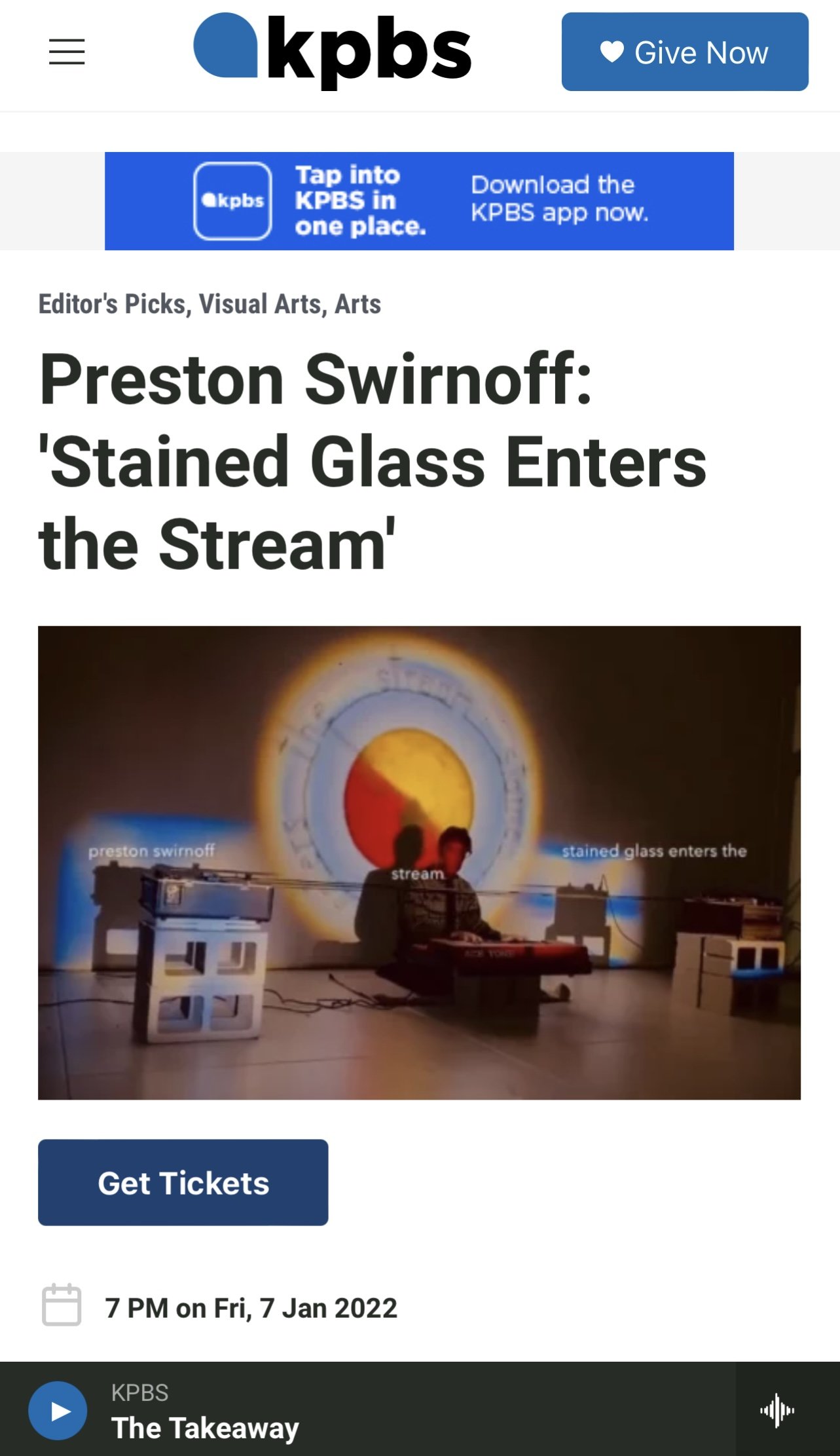preston swirnoff
stained glass enters the stream
with
Spenser Little: kinetic sculpture and lighting
Richard Isabella: production
artist statement
“One thing I do know for certain-- in later life, I shall be a charming, utterly spherical zero.” - Robert Walser (from Jakob Von Gunten)
“…if people didn't feel swept away to Heaven, I was failing. And I really feel that is an absolutely essential element.” - La Monte Young
This performance and installation is based on my new piece ‘At 639 Hz Stained Glass Enters the Stream’ that was debuted at the Jacumba Hot Springs Bath House in November 2021. The piece is composed in a circle, meaning it has no beginning or end, akin to Indian raga and other Asian and African folk musics. It contains a melodic structure with a fundamental or ‘tonic’ frequency (what we call E flat in western classical music) used to build a chord as drone with musical motifs, which have “the ability to ‘colour the mind’ and affect the emotions, moods, and perceptions of the audience”. This aligns with my general view of the musician/composer/sound artist as one who is responsible for manipulating frequencies and vibrating air molecules in time and space to be heard (and felt) by listeners.
Because the music was inspired by the presence of my body at special spaces during a specified time, this music only comes to life by the presence of bodies to complete its circle through the listener, the one present. It contains circular movement, tangible, visible, kinetic and unpredictable. This is the analog tape that loops between two machines and has been imprinted with a specially tuned chord of sine waves with that fundamental E flat as the anchor, even though it’s only implied. I, as the player, fill in the fundamental in real time on the organ to complete that chord and bring it to fruition, much like an empty temple is only completed by the visit of worshippers. The tape is suspended by tension across the platform, hanging in the air, wobbling as it rotates through the play heads, unfolding with each circumvolution. The longer it plays, the more nuanced, the more subtle, the more inside of the chord the listener can hear. The idiosyncracy of the tape, the amplifier, the room and its dimensions, all affect how it reaches our ears. If the tape is the empty temple, I am the worshipper at the organ, delivering my prayer as honestly as I can in order to complete that chord by playing with it, getting inside of it, dancing around it. I alternate between playing complementary chords to build shifting drones that enter and exit like light through the glass, and improvised melodic motifs that often surprise me as much as anyone: I hear the music of my great grandparents, of my childhood piano teacher, of the Mediterranean Steppe, of the Eastern Orthodox tradition, the postwar composers, the 20th century minimalists, the spiritual jazz of America, somehow it’s all in there. Each time, a bit different but only if you’re listening closely. From the outside it sounds largely the same.
The inspiration (inspirare~ to breathe in) for this piece came from my Oct 2021 travels through ancient holy sites, medieval and renaissance churches, catacombs and arcosolia, and mikvot (Jewish ritual baths hidden underground) in Sicily and other areas of southern Italy. Being present at these impactful architectural wonders, rich with history, ghosts, faiths, sacrifices, rituals, worship, hope, despair, and the weathering of time and the atmosphere created a sort of synesthesia- a deep tone ringing on and on, long after my visits were over. The tone was in the range of a very low E flat, and this drone haunted me when I returned home. Was I hallucinating? Going psychotic? Not at all, friends- I was just hearing what I saw, much as Alexander Scriabin saw what he heard. I’ve always been a visual person. Even though my two main forms of art are music and writing, I often only begin composing or writing in response to my mental cinema, either real or imagined. I don’t mean that I want to compose soundtracks to imaginary films- this is a superficial and not very interesting way to make music for me. Instead, it’s more like being in the presence of a beautiful woman and after she leaves still feeling her there, influencing much of what you feel long after she is gone, in other words, a muse. So I realized that these monuments were my muses- the stained glass must enter the stream in order to get to that other shore. Now that I had experienced the power of these sites, what was I going to do with it? Where does all of that feeling go? Pilgrimages to pagan temples and old churches will not deliver anyone the holy grail or solve anyone’s metaphysical problems, but neither will that beautiful woman; in fact, she often creates more problems than she solves, and so do churches and temples! A muse doesn’t give us any answers, only inspiration in the form of more questions, more mysteries, more circles that go around in space and time; a circumference that transcends the profane and the mundane even if only for a few moments. If that’s not a definition of art’s function or at least one of its ideals, I don’t know what is.
-Preston Swirnoff Jan 2022
technical notes about the music











